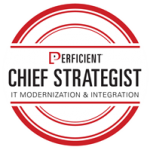Many organizations face cultural inertia against IT modernization. Companies typically treat IT as a cost center because of a history of expensive programs with cost overruns and missed deadlines. In a recent IDG survey, 64 percent of respondents cited outdated/legacy IT infrastructure among their top barriers to IT transformation. Therefore, implementing IT modernization strategies has become critical.
Digital continues to disrupt industries. As a result, legacy business models have to transform – and with a sense of urgency. IT must lead as an innovator and be the source of new digital business models and products. Leading organizations continue to deliver distinct business value using the most current data in the most consumable way.
Digital initiatives are the top priority for 2019. Only four percent of organizations have no digital initiative at all. This signals an overall shift to digital as a mainstream platform, according to Gartner.
Without a rapid change, many companies will be caught in a death spiral. The longer they wait to change, the more radical the change must be in order to survive.
2 IT Modernization Strategies to Consider Now:
1. Take a Phased Approach
Compelling reasons for modernizing legacy IT applications and processes include:
- facilitating business agility
- participating in the digital economy
- improving customers’ user experience
All considered, to modernize legacy systems, you must simultaneously address platforms, people, and processes to transform IT. This requires planning and organizational change management, including monitoring and making adjustments for ongoing business and market changes. Start with an incremental IT modernization program. Planning for incremental benefits and rapid paybacks reassures business leaders that IT is on the right track. As a result, this builds momentum and secures funds for future investment.
2. Create a Roadmap
From a strategic perspective, address and remediate systems with the greatest potential to positively impact your business in terms of revenue, cost, and customer experience. Creating a migration roadmap aligns your business goals and desired outcomes with systems, plans, and activities that add incremental value throughout the transformation.
When considering your IT architecture, analyze and model the current state of your application portfolio. Categorize systems by complexity, risk, dependencies, and business capabilities. Then, align your strategic and architectural views to create a comprehensive transformation roadmap. Lastly, create model diagrams of future-state application architecture that show transitions over time and reflect the future organization of your application domain and reference architecture.
SUCCESS STORY
Refreshed Apps Recover Loss in Market Share
We helped a financial services client that was losing customers to more innovative competitors. The company’s systems were established on mainframes. Consequently, it had a poor set of client-facing applications.
The business wanted to rapidly implement more engaging customer-facing applications, but it lacked the platforms, people, and process to support more modern applications.
Our approach included:
- a platform selection
- best practices
- IT organizational change
- an innovation lab
- a series of incremental project wins
We helped the client quickly deliver a mobile application that, from the user’s perspective, seamlessly integrated with the mainframe. As a result, the engagement jump-started a successful three-year IT transformation.
Want More Digital Transformation Advice?
My insights into IT modernization strategies for this blog post draw from Perficient’s e-book, “How to Make Digital Transformation Gains in 2019.” In it, my fellow Perficient Chief Strategists and I share real-world examples from conversations with today’s leading brands at various stages of digital transformation. Our 10-chapter e-book features our business insights, actions to take now, and client success stories. Download it here or via the form below.
Stay Tuned
This blog series is part of a special series inspired by our e-book. In the next post, my fellow Chief Strategist Jim Hertzfeld will share advice for how to stay on top of customer expectations.
Subscribe to our Digital Transformation weekly digest here to get the blog posts automatically delivered to your inbox every week. Or, follow our Digital Transformation blog for this series and advice on the topic from all of our thought leaders.
 About the Author
About the Author
Eric Roch has more than 30 years of experience in Information Technology. He’s held various roles with responsibilities around enterprise architecture, strategy, operational excellence, and software engineering. With 15 years of executive leadership in IT consulting, his related business experience includes IT strategic planning and the management of profitable, high-growth consulting organizations. His technical experience includes enterprise architect for distributed systems, SOA and APIs, legacy migration, cloud computing, and DevOps.

